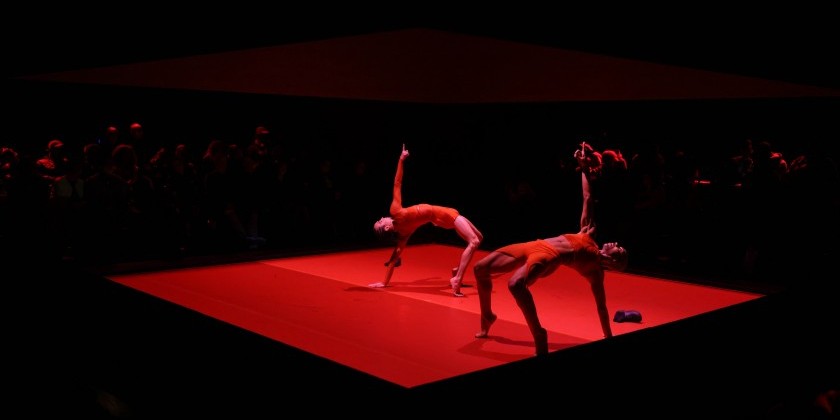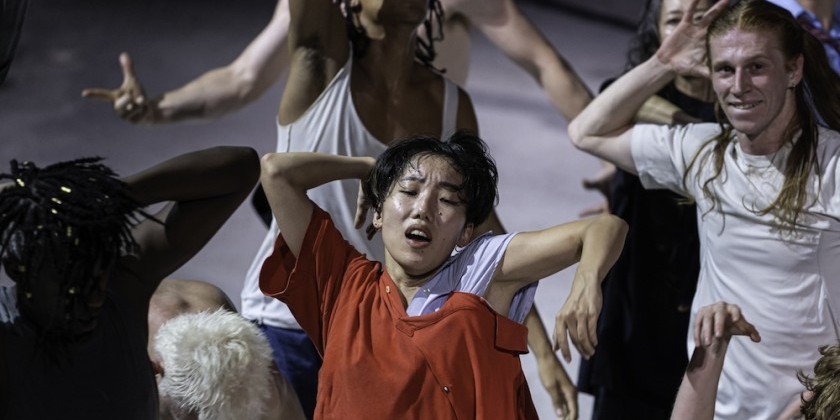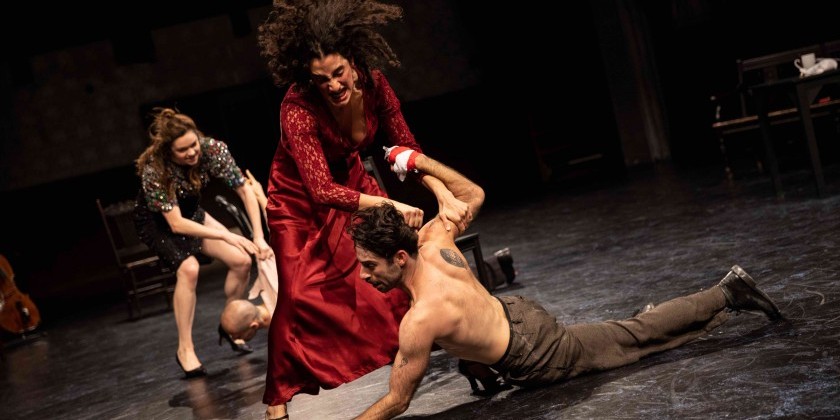IMPRESSIONS: New York Live Arts presents Shamel Pitts' TRIBE in "Touch of RED"

Concept Direction & Choreography: Shamel Pitts
Performers: Tushrik Fredericks and Shamel Pitts
Artistic Production Manager and Lighting Designer: Rus Snelling
Video Light & Mapping Designer: Lucca Del Carlo | Video Installation Consultant: Rumwolf Video Productions
Assistant Lighting Designer: Domino Mannheim | Set Designer: Mimi Lien // Costume Designer: Dion Lee
Costume Stylists: TT Britt & Tushrik Fredericks | Shoe Apparel: Fulton Cobbler (Brooklyn) - Customized “gloves”
Original Musical Score: Sivan Jacobovitz | Additional Music: Ben Frost - A Single Point of Blinding Light Burial - Forgive | Dramaturge: Ashley Pierre-Louis | Lindy Hop Instructor: LaTasha Barnes
Cinematographer: Taylor Antisdel | Photographers & Cinematographers: The Adeboye Brothers
Creative Director: Mirelle Martins | Stage Manager: Kaz Russell
Dates: April 27 - 29, 2023
Touch of RED, a new work co-created and performed by Shamel Pitts and his Brooklyn-based arts collective, TRIBE, is a duet danced within an elaborate arena designed by 2015 MacArthur Fellow Mimi Lien. As the name implies, red is a central theme of the work, representing both the color, which is everywhere, and Pitts’ childhood nickname. With the space flooded in vibrant crimson light, a plethora of images come to mind — blood, fire, anger, desire, and love.
Although Touch of RED is primarily a dance piece, it could also be considered an immersive performance experience. The show begins as audiences enter the theater in a single file line. At the center of the space stands a red box with walls that almost touch from floor to ceiling, save for a wide gap through which we view Pitts and his partner Tushrik Fredericks. They’re already dancing as we take our seats. The choreography is hypnotically groovy, stepping and pulsating to the ambient EDM score by Sivan Jacobovitz. Huddled together and rotating, their movements are contained, delicate and deliciously intimate.

With the house lights at full brightness and the audience seated in the round, I can see everyone across from me, and they can see me. I feel like a spectator at a sporting event whose face is being televised on the big screen, and I suddenly miss the anonymity and voyeurism of a dark theater. All of us around the red ring are as much a part of the performance as Pitts and Fredericks at the center.
Seeing all of us gathered around this bizarre red structure, I realize how wonderfully absurd the ritual of performance is. Like the congregation of a church, or fans at a football game, we are here to witness something sacred and primal. Considering that Touch of RED is inspired by nightlife, it makes sense that parallels are drawn between the ritualistic nature of both concert and social dance.

Seeing a strobe light flash against Pitts’ and Fredericks’ skin-tight mesh as they bop to EDM, I feel like I’m with them on the dance floor of grungy club. However, their movement language remains timeless, influenced by nightlife of both present and past. There are moments when they dance claustrophobically close, as if they have very little space to move in the center of a crowd, yet we can feel the bass vibrating and moving them at a cellular level. At other times, their movement echoes an era of a time gone by—when going to the club meant taking up space and swinging out to a jazz big band. I recognize fast footwork borrowed from Lindy Hop, Balboa, and tap dance. Sometimes they skip and jump, “dancing around the ring” as boxers do. These movements represent the few socially acceptable ways that strangers connect physically, often for only minutes at a time, in a surprisingly raw, uncodified, and intimate way.

The most successful sections in Touch of RED walk the thin line between aggression and tenderness. Mimicking a fight scene, Pitts and Fredericks try to hug each other but can’t. They grapple but never embrace, using so much force that they push each other over. Playing with the inherent eroticism present in tackle sports, they writhe and twist on the floor, grunting, panting, and giggling as their limbs entangle in every imaginable position. I see the duality in the symbolism. Fighting their own feelings, their hug is impossibly stiff, yet a deadly struggle reveals their mutual desire for intimacy, compassion, and play. Every movement is carefully considered, whether it’s a decisive jab charged with physical power, or a touch filled with emotional sensitivity. Pitts and Fredericks exhibit how touch can be wielded as a weapon to hurt and divide, or as an antidote to heal and unite.

At the climax, the walls of the arena come down, and so do the figurative walls between Pitts, Fredericks, and the audience, unleashing a torrent of pent-up fragility. After nearly an hour of mounting tension, I exhale in relief as Pitts and Fredericks finally embrace. In this bewitching investigation of physical connection, Pitts and Fredericks demonstrate that male vulnerability is a misconstrued sign of weakness that ought to be embraced as their greatest strength.












